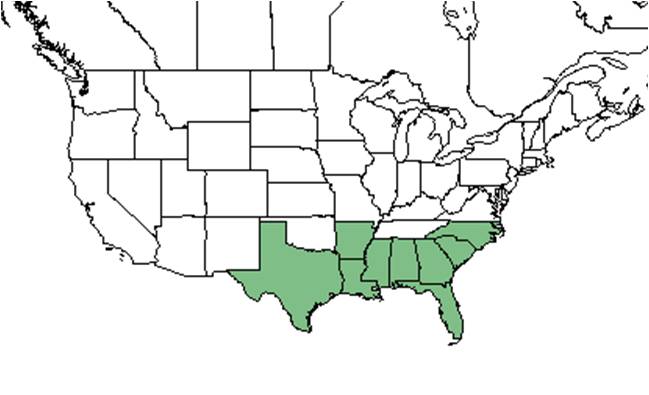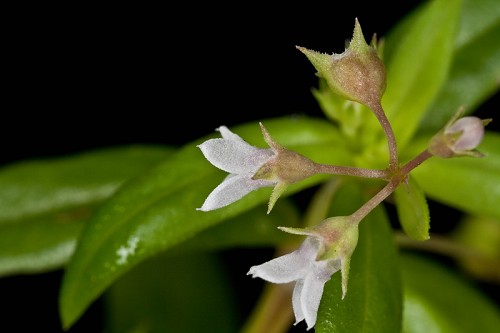Oldenlandia corymbosa
| Oldenlandia corymbosa | |
|---|---|

| |
| Photo by John R. Gwaltney, Southeastern Flora.com | |
| Scientific classification | |
| Kingdom: | Plantae |
| Division: | Magnoliophyta - Flowering plants |
| Class: | Magnoliopsida – Dicotyledons |
| Order: | Rubiales |
| Family: | Rubiaceae |
| Genus: | Oldenlandia |
| Species: | O. corymbosa |
| Binomial name | |
| Oldenlandia corymbosa L. | |

| |
| Natural range of Oldenlandia corymbosa from USDA NRCS Plants Database. | |
Common names: Flat-top mille graines; Diamond-flower[1]
Contents
Taxonomic notes
Synonyms: Hedyotis corymbosa (Linnaeus) Lamarck.[1]
Varieties: none.[1]
Description
"Diffuse annuals or perennials with opposite, sessile or subsessile leaves connected by fimbriate stipules. Flowers axillary or in few-flowered cymes; calyx lobes 4; corolla white, rotate, minute, shorter than the calyx; stamens 4. Capsule enclosed in the calyx, the apex splitting to release the numerous, minute seeds."[2]
"Slender, branched, spreading, glabrous annual with erect or decumbent stems 2-5 dm long. Leaves elliptic to linear-elliptic, the largest 1.5-2.5 cm long, 4-7 mm wide. Flower axillary, peduncles filiform, 5-10 mm long, pedicels filiform, 3-5 mm long; calyx glabrous, 1-1.5 mm long, lobes minute, subulate. Seeds brown, angled, ca. 0.2 mm long or broad."[2]
Distribution
This plant is a native of South America, but has been reported in North Carolina.[1]
Ecology
Habitat
Oldenlandia corymbosa has been found growing on exposed sandbars in rivers, sidewalk gravel, cracks of concrete, and loamy sand of an open planted peanut field.[3] Soil types include loamy sand, sandy loam, sandy alluvium, and clayey sand.[3]
Phenology
This plant flowers from July through October.[1][4]
Pollination
The following Hymenoptera families and species were observed visiting flowers of Oldenlandia corymbosa at Archbold Biological Station:[5]
Halictidae: Lasioglossum lepidii, L. placidensis, L. puteulanum
Sphecidae: Cerceris blakei, C. tolteca
Conservation and management
Cultivation and restoration
Photo Gallery
Flowers of Oldenlandia corymbosa Photo by John R. Gwaltney, Southeastern Flora.com
References and notes
- ↑ 1.0 1.1 1.2 1.3 1.4 Weakley, A.S. 2015. Flora of the southern and mid-atlantic states. Working Draft of 21 May 2015. University of North Carolina at Chapel Hill, Chapel Hill, North Carolina.
- ↑ 2.0 2.1 Radford, Albert E., Harry E. Ahles, and C. Ritchie Bell. Manual of the Vascular Flora of the Carolinas. 1964, 1968. The University of North Carolina Press. 981. Print.
- ↑ 3.0 3.1 Florida State University Robert K. Godfrey Herbarium database. URL: http://herbarium.bio.fsu.edu. Last accessed: October 2015. Collectors: Loran C. Anderson, R.K. Godfrey, Sidney McDaniel, Annie Schmidt. States and Counties: Florida: Calhoun, Franklin, Gadsden, Gulf, Jackson, Lafayette, Leon, Liberty, Suwannee. Countries: Costa Rica, Panama. Compiled by Tall Timbers Research Station and Land Conservancy.
- ↑ Nelson, G. PanFlora: Plant data for the eastern United States with emphasis on the Southeastern Coastal Plains, Florida, and the Florida Panhandle. www.gilnelson.com/PanFlora/ Accessed: 19 MAY 2021
- ↑ Deyrup, M.A. and N.D. 2015. Database of observations of Hymenoptera visitations to flowers of plants on Archbold Biological Station, Florida, USA.
